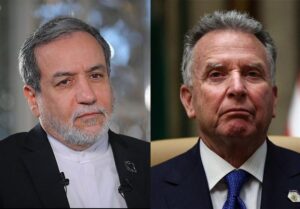In Oman today, the United States and Iran appear to have taken the first steps that could lead to a new agreement to limit Iran’s nuclear activities and lift U.S. economic sanctions.
Iran-US negotiations and an overview
On social media, the Omani foreign minister, who mediated today’s indirect talks, said they “took place in a friendly atmosphere conducive to bridging viewpoints.”
The White House described the meeting as “very positive and constructive.”
The Iranian foreign minister said the two sides briefly interacted when their paths crossed at the end of today’s session and that they will meet again next Saturday.
Karim Sadjadpour is a senior fellow at the Carnegie Endowment for International Peace. He focuses on Iran and U.S. Middle East policy.
A brief encounter in the hallway, agreements to meet again—is this as much as one could hope?
Karim: “The fact they agreed on a second meeting is as much as anyone could have hoped for, but our expectations should be realistic. This is not a negotiation. This is not normalization of relations. This is whether the two sides can agree on something that limits Iran’s nuclear program, which will be a tall order.”
President Trump said he would like a stronger agreement than the one President Obama got. Is that possible?
Karim:” I think that will be difficult for President Trump because when he pulled out of the deal, Iran put its foot on the gas. When you think of getting a nuclear bomb as a 26-mile marathon, Iran is at mile 25. President Trump will have a hard time reversing the program significantly, and if he’s not able to do that, he will have to answer to two constituencies: Congressional Republicans and Israel. Whether those groups will accept Trump signing off on a deal weaker than Obama’s remains to be seen.”
The Iranian foreign minister mentioned another of Trump’s goals—reaching an agreement quickly. Is speed a potential pitfall?
Karim: “These negotiations are about the science of verification, not the art of the deal. There’s an expertise imbalance—Iran’s diplomats have decades of experience in these talks, while the U.S. team has only focused on this for months. Speed shouldn’t compromise technical precision.”
Moreover, Iran-US negotiations are complicated by Iran’s 60% uranium enrichment.
What’s motivating each side?
Karim: “Iran faces severe sanctions and military vulnerabilities. For the U.S., Iran’s nuclear progress creates urgency. Both sides see tactical benefits, but long-term reconciliation is unlikely given Iran’s ideological resistance to America.”
Also in the Middle East, Israeli forces say they’ve encircled Rafah in southern Gaza, urging evacuations as operations expand. Hamas warns it can’t guarantee hostage safety amid ongoing strikes.
In trade news, the Trump administration exempted smartphones and laptops from new China tariffs, sparing tech companies like Apple from price hikes.
President Trump, 78, declared himself in “good shape” after his physical, contrasting his health with Biden’s and claiming he aced a cognitive test.
The CDC reports measles cases in half the U.S., with over 700 infections—double last year’s total. Texas leads with 541 cases.
Why surprise fees are inflating medical bills, and how disabled parents redefine resilience.
Next, hidden hospital fees hitting patients at routine doctor visits. Special correspondent Megan Thompson investigates “facility fees”—charges tacked on even for outpatient care.
Jess Ayers was stunned by a $176 “hospital charge” after her daughter’s eye exam at a clinic—part of Minnesota’s M Health Fairview system. Experts say such fees are rising as hospitals buy up private practices, leaving patients with higher bills.
Facility fees are pernicious—high, surprising, and often not fully covered by insurance.
Hospitals argue the fees offset overhead, but consolidation lets them inflate prices. States like Minnesota see patients like Kaitlin Johnson billed $24,400 for allergy tests—far above independent clinics’ rates. After PBS inquired, M Health slashed its test price by 80%.
It’s unfair, especially for rural patients with no alternatives.
Why the U.S. Is Forced to Negotiate with Iran: A Multifaceted Imperative
The United States’ decision to re-engage in nuclear talks with Iran—despite decades of hostility—reflects a convergence of strategic necessities, failed policies, and shifting global dynamics. Below are the key reasons compelling Washington to return to the negotiating table. Conversely, Iran-US negotiations could collapse if hardliners on either side reject compromises.
1.Iran’s Nuclear Advancements: The Ticking Clock
Iran’s nuclear program has reached unprecedented levels since the U.S. withdrew from the JCPOA in 2018. Today, Iran:
- Enriches uranium at 60% purity (just shy of weapons-grade 90%).
- Stores over 120 kg of 60%-enriched uranium—enough for multiple bombs if further enriched.
- Operates advanced centrifuges (IR-6 and IR-9) that accelerate production.
- Restricts IAEA monitoring, raising fears of covert progress.
Why this forces U.S. action:
- The “breakout time” (time needed to produce a bomb’s worth of fissile material) has shrunk from 12 months under the JCPOA to mere weeks.
- Military strikes (e.g., by Israel) risk triggering a regional war but cannot permanently destroy Iran’s dispersed, fortified nuclear sites.
- Diplomacy is the least bad option to prevent a nuclear Iran.
2. The Failure of “Maximum Pressure”
The Trump administration’s sanctions campaign (2018–2021) failed to collapse Iran’s regime or halt its nuclear program. Instead:
- Iran adapted via smuggling, local production, and trade with China/Russia.
- Oil exports rebounded to 1.5M barrels/day (2023) despite sanctions.
- Regional proxies (Hezbollah, Houthis) grew stronger, proving sanctions didn’t curb Iran’s influence.
Result: Furthermore, Iran-US negotiations are influenced by global players like China and Russia. The U.S. lacks leverage to demand unilateral concessions. Negotiations are now a necessity, not a choice.
3. Escalating Regional Conflicts
Iran’s “axis of resistance” (from Gaza to Yemen) has raised the stakes:
Hamas’s Oct. 7 attack and Hezbollah’s threats show Iran’s ability to destabilize the Middle East.
Houthi attacks on Red Sea shipping disrupt global trade, pressuring the U.S. to de-escalate.
Direct strikes between Iran and Israel (e.g., April 2024) risk spiraling into war.
U.S. Dilemma:
Military action risks a wider war (and $200/barrel oil).
Diplomacy offers a path to curb Iran’s nuclear program and regional aggression.
4. International Isolation & Allies’ Pressure
The U.S. faces dwindling support for its hardline stance:
Europe still backs the JCPOA and opposes new sanctions.
China & Russia trade with Iran openly, undermining U.S. sanctions.
Global South views U.S. policy as hypocritical (e.g., overlooking Israel’s nukes).
Impact: Without allies, unilateral U.S. pressure is ineffective. Negotiations restore multilateral coordination.
5. Domestic U.S. Politics
Conversely, hardliners in both countries oppose compromise, risking deadlock. Biden’s calculus is shaped by:
2024 Elections: A war with Iran or a nuclear crisis would hurt reelection chances.
War Fatigue: Americans oppose another Middle East conflict (per Pew Research).
Democratic Base: Progressives demand diplomacy over militarism.
Result: Biden must show diplomatic progress to voters.
6. Iran’s Counter-Pressure Tactics
Furthermore, global powers like China and Russia influence the negotiations behind the scenes. Iran has exploited U.S. vulnerabilities:
- Hostage Diplomacy: Jailing dual nationals (e.g., Morad Tahbaz) to extract concessions.
- Nuclear Brinkmanship: Threatening 90% enrichment to force sanctions relief.
- Alliances with China/Russia: Reducing reliance on the West.
U.S. Response: Talks are the only way to avoid further escalation.
Conclusion: A Forced Negotiation
The U.S. isn’t negotiating with Iran out of strength but from recognition that alternatives (war, sanctions, isolation) have failed. Key takeaways:
- Iran’s nuclear program is too advanced to ignore.
- Sanctions alone won’t work—Iran has adapted.
- Regional chaos demands de-escalation.
- Global allies won’t support endless pressure.
- Domestic politics favor diplomacy.
Ultimately, the U.S. is at the table not because it wants to be, but because it has no better option. Finally, the outcome could reshape Middle East stability and nonproliferation efforts. Finally, Iran-US negotiations will determine the future of nuclear nonproliferation in the Middle East.
you can read more about Iran-US negotiations here and watch more about Iran-US negotiations:


